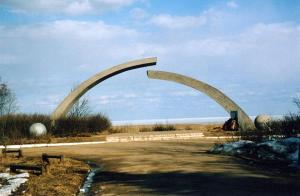Articles
/
"The Road of Life", monuments
"The Road of Life", monuments
Subject /
Architecture/Sculpture, monuments, memorials
The monuments "The Road of Life". "The Road of Life" was only military-strategic transport arterial road passed through Ladoga Lake and connected blockade Leningrad with the country (the official name is the military transport road) from September 1941 till March 1943. The memory about "The Road of Life" was immortalized at monuments and memorial ensembles included into "The Freen Belt of Glory". The first monuments were built in the 1950s: in 1958 on the shore of Ladoga Lake the obelisk was erected in the memory about the 101nd Battery which defended "The Road of Life". The most famous memorials were built in the 1960s. Every kilometre of the motor road (45 kilometres) and railway (56 kilometres) was marked with a memorable post (1967-1970, architects M.N. Meisel, I.G. Yavein). The first memorial laying stone was placed at the 9th kilometre (1965, the architect M.N. Meisel). The memorial "The Flower of Life" (1968, architects A.D. Levenkov, P.I. Melnikov) built in the memory about Leningrad children was erected at the 3d kilometre of the road. A feat of pilots defended Leningrad was immortalized in the memorial "The Baltic Wings" located at the 5th km of the road (1968, the architect A.D. Levenkov). At the 10th km of the road there is the memorial "Rumbolovskaya Mountain" (1967, architects P.F. Kozlov, V.N. Polukhin). On the mountain top there is the memorial common grave of Leningrad defenders perished on "The Road of Life" during 1941-1943 or died of wounds. The monument "Katyusha" (1965, architects A.D. Levenkov, P.I. Melnikov, L.V. Chulkevich) was built at the 17th km where a flak battery was located in 1941-1943. The memorial "The Broken Ring" (1966, architects V.G. Filippov, K.M. Simun) was erected at the 40th km of the road. At the 45th km there is the memorial "The Ladoga Burial Mound" (1969) which is the symbolic common grave of sailors, drivers, naval academies cadets perished on Ladoga in 1941-1943. The new memorials: the memorial "The Steel Way" (1972, the architect I.G. Yavein, the artist G.D. Glikman) built in the memory of the feat of railway workers at the railway station of Petrokrepost; the monument "The Armour" (1975, the architect I.G. Yavein, the artist G.D. Glikman, the sculptor A.V. Aristov) included into the the memorial "The Ladoga Burial Mound" were opened in the 1970s. On September 12, 1972 the museum "The Road of Life" was opened in the settlement Osinovets. In the 1980s the obelisk "The Road of Victory" (1983, the architect V.N. Trofimov) was erected opposite the fortress Oreshek. The obelisk was built in the memory of the first train dispatched to Leningrad after the beginning of the blockade. At the 12th km of "The Road of Life" in 1983 the section of the military road with the extension 380 metres and with cobblestone cover was restored. Nearby there are 3 memorial steles. The official quantity of people evacuated from Leningrad along "The Road of Life": 1.2 millions of people is written on a stele. The memorial stele "A Traffic-controller" (1986, sculptors Ya.I. Imranov, B.A. Izborsky) was erected at the railway station Rzhevka. A bas-relief (1990, the atchitect A.P. Chernov, the sculptor A.A. Arkhipov) was fixed in memory of the gunnery of March 29, 1942 on the railway station building. Most of memorials were restored by the 60th anniversary of the Victory. New memorials are built. On February 23, 2006 the embedded glagstone for the memorial to the deceaseds in Ladoga Lake was opened in the settlement Osinovets.
Authors
Karpenko, Irina Aleksandrovna
Persons
Aristov, A.V.
Arkhipov, Aleksey Andreyevich
Chernov, Anatoly Petrovich
Chinyakov, E.V.
Chulkevich, Lev Vyacheslavovich
Filippov, Vladimir Gavrilovich
Glikman, Gavriil Davidovich
Imranov, Y.I.
Izborsky, B.A.
Kozlov, Pavel Filippovich
Levenkov, Aleksandr Danilovich
Meisel, Mikhail Nikolayevich
Melnikov, Pavel Ivanovich
Pavlov, I.I.
Polukhin, Victor Nikolayevich
Simun, Konstantin Mikhelevich
Trofimov, V.N.
Yavein, Igor Georgiyevich
Geography
Leningrad Oblast, the/Kirovsk District/Kobona Village
Topographical landmarks/Ladoga Lake
Leningrad Oblast, the/Lodeynoye Pole District/Lodeynoye Pole Town
Leningrad Oblast, the/Vsevolozhsk District/Osinovets, settlement
Leningrad Oblast, the/Vsevolozhsk District/Petrokrepost Railway Station
Leningrad Oblast, the/Vsevolozhsk District/Vaganovo Village
Bibliography
Богданов Н. Мемориальный ансамбль «Дорога жизни». СПБ., 2003, 3-17
Достопримечательности Ленинградской области / Сост. И.А.Орлова. Л., 1977., 277-306
Лукьянов Ю.А. Рубежи стойкости и мужества. Л., 1985., 82-144
Мелуа А. Блокада Ленинграда. М.; СПб., 1999, 6-15
Павлюченко В.Ф., Редькин П.Л. Музей «Дорога жизни». Л., 1988, 9-20
Семенова Т.М. «Каменная летопись» Великой Отечественной войны // Труды ГМИ СПб. Вып. 5. СПб., 2000, С. 324-343
Subject Index
"Armour", a monument
"Green Belt of Glory", memorial constructions complex
"Katyusha" , a monument
"Ladoga Burial Mound", a memorial
Oreshek, see Schlusselburg Fortress
"Road of Victory", an obelisk
"Steel Way", monument
"The Broken Ring", memorial
"The Flower of Life", a memorial
"The Road of Life", a museum (the settlement of Osinovets)
"Traffic Polis - Woman", a monument
"Wings of Baltic", a monument
Mentioned in articles:
|
hidden
|
"The Broken Ring", memorial
The memorial "The Broken Ring" is included into "The Green Belt of Glory" and located on the western shore of Ladoga Lake. It was built in 1966 by workers of the Kalininsky district of Leningrad to the east of the village of Vaganovo at the... more
|
|
|
|
hidden
|
Vsevolozhsk District
VSEVOLOZHSK DISTRICT, a part of Leningrad Oblast. Area: 2945.4 sq. km. Population: 215,200. Adm. center: Vsevolozhsk Town. Comprises Sertolovo Town, six urban settlements (Dubrovka, settlement named after Morozov, settlement named after Sverdlov,... more
|
|
|
|
hidden
|
Vsevolozhsk Town coat of arms and flag, the
The Vsevolozhsk Town's coat of arms and flag are the official approved symbols of the Municipal Union “Vsevolozhskoye gorodskoye poselenie” (the urban-type settlement of Vsevolozhsk) (they were approved with the decision of the Soviet of Deputies... more
|
|
|
|











